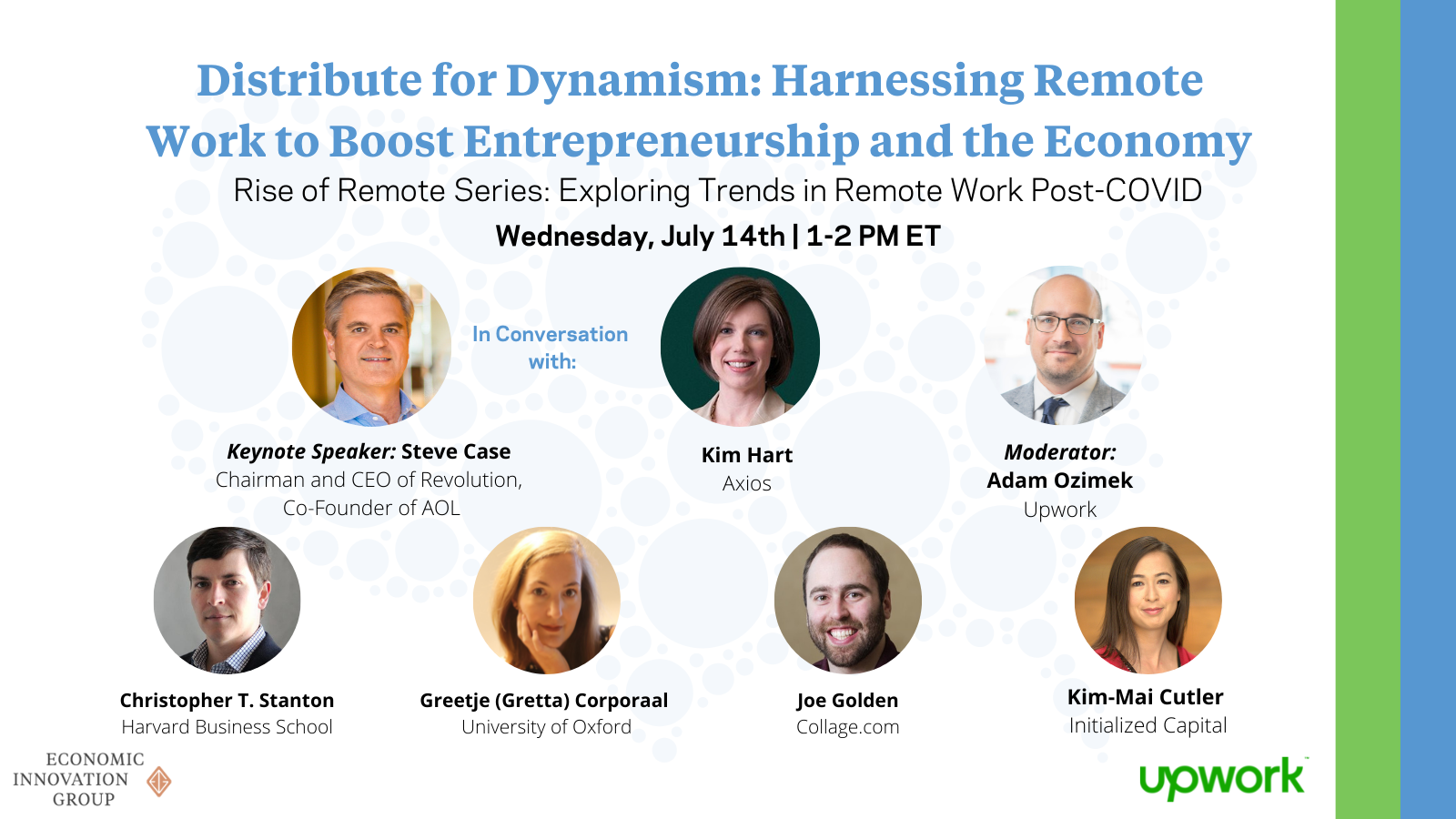By Emma Hecker
On July 14th, the Economic Innovation Group (EIG), in partnership with Upwork, hosted our final session in the “Rise of Remote Series,” a three-part series of virtual events exploring the long-term impacts of remote work for the U.S. economy, workers, and communities. View a recording of the event and key takeaways below for more information.
As Covid-19 shuttered the U.S. economy and forced millions of Americans out of the workforce, a surprising trend emerged: new business applications surged. After more than a decade of declining startup rates following the Great Recession, 2020 saw a dramatic increase in new firm creation. More than 200,000 additional high-propensity applications ( the Census Bureau has identified these applications as having a high likelihood of becoming active businesses with employees quickly after filing) were filed in 2020 than 2019, totaling over 1.5 million (a 16 percent increase over 2019 numbers) by year’s end. Those numbers left many economists wondering how a global health crisis that effectively paused economic activity for much of the year could catalyze such an unexpected jump in potential new business applications and entrepreneurship.
The third and final session in EIG’s Rise of Remote Series aimed to explore this surprising and unprecedented rise in new business applications throughout the pandemic. Panelists also discussed how we can continue to tap into the “remote work revolution” to further boost entrepreneurship across the country and shore up economic dynamism in the process. The webinar began with a moderated conversation between Steve Case (chairman and CEO of Revolution and co-founder of AOL) and Axios’ Kim Hart, followed by a live panel discussion between Christopher T. Stanton (Harvard Business School), Gretta Corporaal (University of Oxford), Joe Golden (College.com) and Kim-Mai Cutler (Initialized Capital), moderated by Adam Ozimek (Upwork).
Watch a recording of the event and EIG’s key takeaways below for more information.
Key Takeaways
How small and mid-sized cities can leverage the rise of remote to attract new businesses
- Steve Case explained that “more and more [cities] realized that their core economic development strategy couldn’t just focus on existing businesses…they had to focus on new businesses.”
- Case also stated that he predicts “it’s going to be dozens of cities that benefit from this ‘rise of the rest’ phenomenon, not just a few. And I think that’s going to be the story of our innovation economy over the next 10 or 20 years.”
- “The slowdown in dynamism in the United States has been more heavily concentrated in places that are demographically struggling,” said Adam Ozimek. “It really raises an important question about the importance of remote work: Is it going to make it easier to form a startup outside of superstar cities? Is it going to help spread dynamism throughout the country?”
How remote work has impacted small businesses, big businesses, and startups
- Chris Stanton explained that “many small businesses are located in places where labor markets might be a little bit thin. And remote does quite a lot to open the world to people that wouldn’t have had access to global talent otherwise.”
- Ozimek explained how freelancers and the self-employed tie in: “To really take advantage of the freelance platforms…you need to make organizational changes sometimes. And I think the same thing is true of remote work as well.”
- “When [startups] are more mature…I think that it’s easier to have a remote team,” offered Kim-Mai Cutler.
Dynamism and digital labor markets
- One of the biggest advantages of remote work is the ability for companies to hire workers from around the country and around the world. “Your access to an expanded talent pool makes it worthwhile,” said Joe Golden.
- “The availability to match with new sources of talent is likely to drive dynamism on the new firm side,” said Stanton.
- “The puzzle that I’ve struggled with is why we haven’t seen these markets get bigger,” said Stanton. That could be due to “organizational frictions to adoption,” he concluded.
- “[Digital labor platforms]…afford large firms the flexibility to hire the best talent in the world,” said Gretta Corporaal. “This value proposition is what drives adoption.”
The changing geography of venture capital and the rise in remote entrepreneurship
- During the pandemic we’ve seen “more venture capital backing more entrepreneurs in more places,” explained Case. “I expect over the next five or 10 years we’ll look back on this as an important tipping point moment.”
- “Our portfolio has become more geographically diverse over the last 10 years,” said Cutler. “That said, many of those companies are still located in major cities…[and] I think what realistically could end up happening is companies are still going to get headquartered in [major] cities, but they might have talent located somewhere else.”
- “I think in a lot of ways it’d be much easier to [start a company in the Heartland] than a decade ago,” said Golden. “I think the challenge will be [that] there are a lot more companies that have started that are remote, and a lot of larger companies are either accommodating that or embracing it…so it’s not a hundred percent clear to me in starting a [new business if] it’d be easier or harder to find remote workers since there are countervailing factors on both the supply and demand side.”
- “The data around venture capital is sobering in terms of place. Seventy-five percent of venture capital dollars go to just three states. Even more sobering…if you look at people, women are 50 percent of our population and they get less than 10 percent of venture capital, Black Americans are 13 percent of our population and get less than 1 percent of venture capital. So this idea of leveling the playing field so everybody everywhere really has a shot at the American Dream couldn’t be more important now,” said Case.
On new business formation during the pandemic
- Steve Case described the pandemic as a “shake the snowglobe” moment for many people. We “really saw the dispersion, or maybe re-dispersion of talent and also more venture capital backing more entrepreneurs in more places, so I’m optimistic about what we’ve seen so far,” he added.
- Corporaal explained that, during the pandemic, “companies have figured out how to run their operations remotely…If you enable remote [work], you have the potential to drive value not only by cutting costs but also in terms of reining in knowledge [and] driving innovation” She went further, asking: “Does [remote work] drive the classic urban-rural divide? Does it help solve those issues?”
- “It sounds like we have a lot of reasons to be optimistic about the potential for dynamism to increase as a result of remote work and remote work platforms. But policymakers can’t just sit back and wash their hands and pretend the job is done,” emphasized Ozimek. “We continue to need housing market reform, we need broadband access in most rural places that don’t seem to be benefiting from access to these [remote] jobs yet. And these platforms open up huge skilled work opportunities for people to work in niches and specializations that they might not have had access to, but they still need ways to get that education and ways to get those skills,” he concluded.






